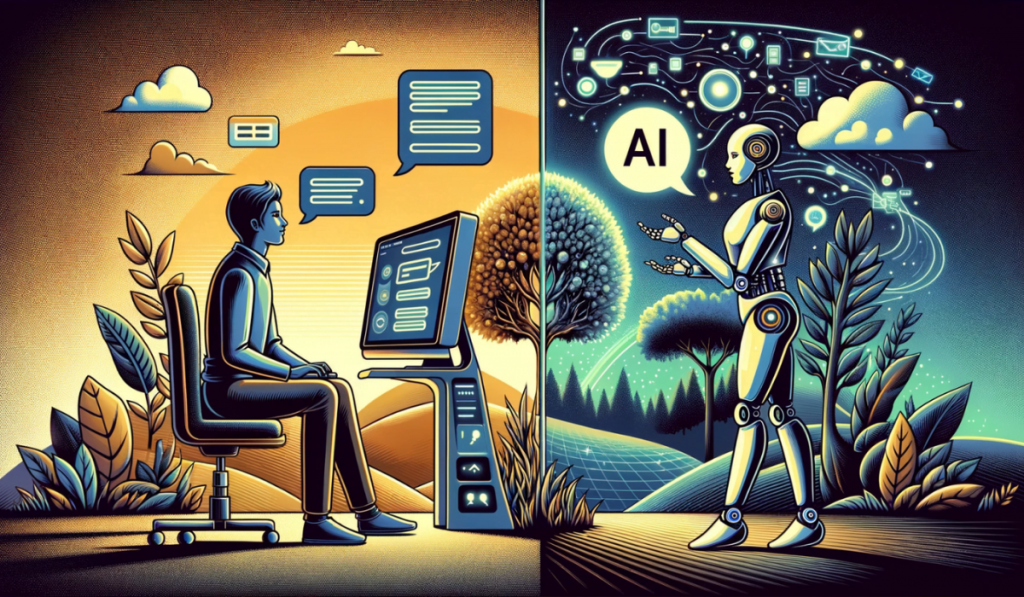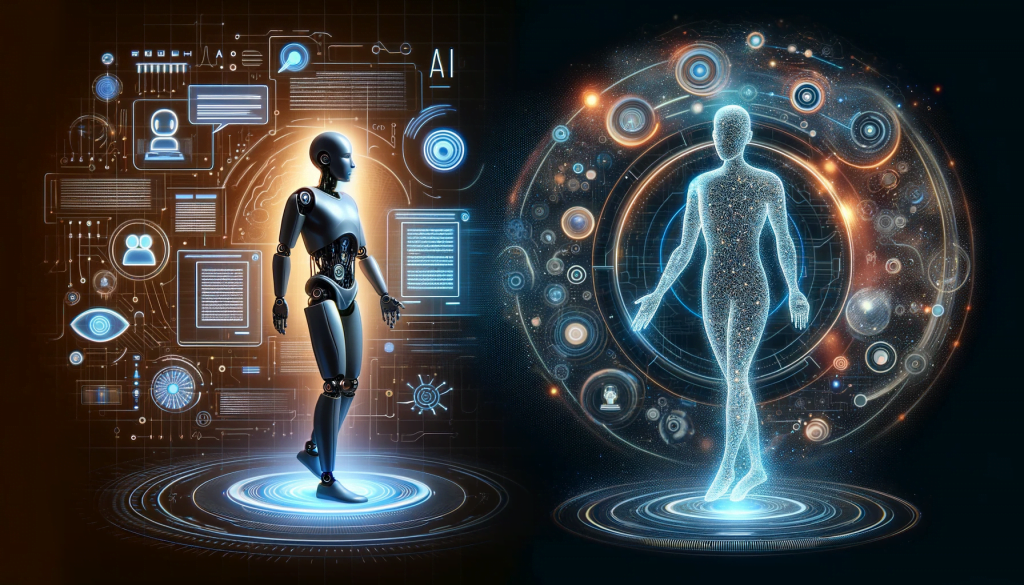When we talk about technology, especially AI, it can sometimes feel like we’re navigating a maze of complex terms. But don’t worry, I’m here to help you understand the difference between “AI chatbot vs. conversational AI” in a simple and engaging way. These terms might sound similar, but they have distinct features and uses. Let’s dive in and explore these exciting AI advancements.
What is an AI Chatbot?
AI chatbots are like your virtual helpers. They’re programmed to respond to specific commands or questions. Imagine you’re asking a robot for the weather forecast or to play your favorite song. That’s what AI chatbots do – they follow set rules to answer your queries.
- Rule-Based Responses: They work on predefined rules.
- Limited Scope: Their knowledge is limited to what they’re programmed for.
- Efficiency: They handle repetitive tasks well.
AI Chatbot Examples
When we talk about AI chatbots, it’s helpful to think about specific examples to better understand their role. These chatbots are designed to perform specific tasks based on a set of rules. They’re like the helpful assistants in various apps and websites, guiding you with predefined responses. Here are some common examples:
- Customer Service Bots: These are the chatbots you often see on shopping websites, ready to help with FAQs like shipping details or return policies.
- Banking Bots: Many banks use chatbots for quick customer inquiries like checking account balances or recent transactions.
- Healthcare Bots: These chatbots can help with appointment scheduling or provide basic health information based on symptoms you input.
If you want to know? Best AI Chatbot Companies in 2025
How Does Conversational AI Differ?
Now, let’s talk about conversational AI. This is where things get a bit more sophisticated. Conversational AI doesn’t just respond to commands; it understands and interacts in a more human-like manner. Think of it as having a conversation with a smart friend who understands context and can learn from past interactions.
- Advanced Understanding: It grasps language nuances and context.
- Learning Ability: It learns from interactions to improve responses.
- More Human-Like Interaction: The conversation feels more natural and less robotic.
Conversational AI Examples
Conversational AI, on the other hand, takes the chatbot idea to the next level. These systems are more advanced, providing a more interactive and personalized experience. They understand context and can handle complex conversations. Here are some examples where conversational AI shines:
- Virtual Personal Assistants: Siri, Alexa, and Google Assistant are prime examples. They understand your questions, learn your preferences, and even recognize your voice.
- Advanced Customer Support: Some businesses use conversational AI to provide in-depth customer support, handling more complex queries than a standard AI chatbot.
- Interactive Voice Response Systems: Used in call centers, these systems can understand spoken language, making customer support calls more efficient and personalized.
In both these cases, AI chatbots and conversational AI are transforming how we interact with technology, making it more intuitive, efficient, and in the case of conversational AI, even more human-like. Whether it’s for simple tasks or complex conversations, these technologies are becoming an integral part of our digital experience.
Please See: Best Mobile App Development Companies in Houston
AI Chatbot vs. Conversational AI: Key Differences

Understanding the key differences between an AI chatbot and conversational AI is crucial for grasping how they function and what they offer. Here are the expanded key points that set them apart:
- Complexity of Conversations: AI chatbots handle simpler, straightforward tasks, whereas conversational AI can manage more complex dialogues, understanding nuances and emotions in the conversation.
- Learning and Adaptation: AI chatbots operate based on predefined rules and do not learn from past interactions. In contrast, conversational AI continuously learns and adapts from each interaction, enhancing its responses over time.
- User Experience: Conversational AI offers a more engaging and personalized user experience, often making users feel like they’re interacting with a human, while AI chatbots provide more transactional, straightforward interactions.
- Integration and Contextual Understanding: Conversational AI can integrate with various data sources and understand the context of a conversation, making it more versatile. AI chatbots, however, work within a limited scope of predefined data and rules.
- Language Processing Capabilities: Conversational AI utilizes advanced natural language processing (NLP) techniques to interpret and generate human-like responses. AI chatbots, on the other hand, rely on simpler pattern recognition and scripted responses.
- Response Generation: Conversational AI can generate unique and contextually relevant responses on the fly. In contrast, AI chatbots typically select from a range of pre-written responses.
- Emotion Recognition: Advanced conversational AI can detect and respond to emotional cues in a conversation, offering empathetic responses. AI chatbots lack this emotional intelligence.
- Customization and Flexibility: Conversational AI systems are more customizable and can be adapted to a wide range of scenarios and industries. AI chatbots are generally less flexible and are often designed for specific tasks.
- Interactivity and Engagement: Conversational AI engages users in a more interactive and dynamic manner, often leading to more satisfying user experiences. AI chatbots, while efficient, may not offer the same level of engagement.
- Use Cases and Applications: The use cases for conversational AI are broader and more complex, including personal assistants, healthcare diagnostics, and customer service. AI chatbots are more commonly used for simpler tasks like answering FAQs or guiding website navigation.
Understanding these differences is key in choosing the right technology for specific needs and applications. As AI continues to evolve, the lines between AI chatbots and conversational AI may blur, leading to even more advanced and seamless interactions.
Comparative Analysis: AI Chatbot vs. Conversational AI
To help clarify the often-confused terms in the realm of artificial intelligence, the following table provides a side-by-side comparison of AI Chatbots and Conversational AI. This comparison highlights their distinct features, capabilities, and applications in a concise and informative manner.
| Feature | AI Chatbot | Conversational AI |
|---|---|---|
| Complexity of Conversations | Handles simple, straightforward tasks | Manages complex dialogues, understands nuances and emotions |
| Learning and Adaptation | Operates on predefined rules, doesn’t learn from interactions | Continuously learns from interactions, enhancing responses over time |
| User Experience | Provides transactional, straightforward interactions | Offers engaging, human-like, personalized experiences |
| Integration and Contextual Understanding | Limited to predefined data and rules | Integrates with various data sources, understands context |
| Language Processing Capabilities | Relies on simpler pattern recognition and scripted responses | Uses advanced natural language processing for human-like responses |
| Response Generation | Selects from a range of pre-written responses | Generates unique, contextually relevant responses on the fly |
| Emotion Recognition | Lacks emotional intelligence | Can detect and respond to emotional cues empathetically |
| Customization and Flexibility | Less flexible, designed for specific tasks | Highly customizable, adaptable to various scenarios |
| Interactivity and Engagement | Efficient but may not offer high engagement | Engages users interactively, leading to satisfying experiences |
| Use Cases and Applications | Suited for simpler tasks like FAQs, website navigation | Suited for broader, complex tasks like personal assistants, healthcare diagnostics |
Also Read: Top 15 Chrome VPN Extensions – 2025
The Future of AI Chatbot vs. Conversational AI

Looking into the future of “AI chatbot vs. conversational AI,” we’re heading towards some exciting times! Here’s what we might see:
- They’ll Be Everywhere: In the future, both AI chatbots and conversational AI could be a part of almost everything we do online. From helping us shop online to giving us health advice, they’ll make things faster and more personal.
- Understanding Feelings: Imagine chatting with AI that not only gets your words but also how you’re feeling. This could change the game in customer service and even in helping us when we’re feeling down.
- Learning and Getting Better: These AI technologies will keep getting smarter. They’ll learn from talking to us and get better at helping us with exactly what we need.
- Talking Across Devices: In the future, these AI technologies might remember us across all our devices. This means a smoother and more connected experience, whether we’re on our phone or using a smart home device.
- Keeping Things Safe: As AI becomes a bigger part of our lives, keeping our information safe will be super important. We can expect better safety features to make sure our data stays private.
- Thinking About What’s Right: As AI grows, we’ll also need to think about making sure it’s used in good ways. It’s all about finding a balance between cool new tech and doing the right thing.
In short, the future of AI chatbots and conversational AI is about making life easier and more connected, while also making sure we use these technologies in a safe and ethical way. It’s an exciting road ahead.
Final Words
Understanding the difference between AI chatbot and conversational AI helps us appreciate how these technologies make our lives easier. As we continue to interact with them, it’s exciting to think about the possibilities they bring. Remember, whether it’s a simple AI chatbot or a more complex conversational AI, these tools are here to make our interactions with technology smoother and more enjoyable.










Leave a Reply